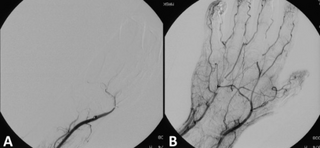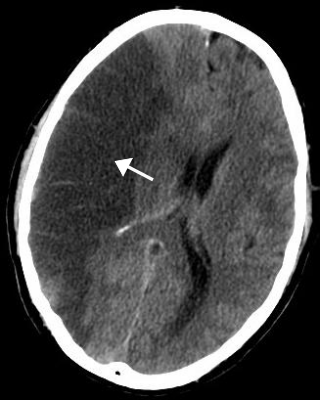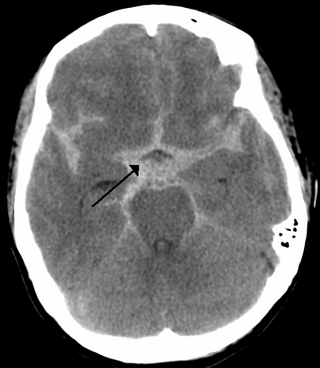Related Research Articles

Cerebrovascular disease includes a variety of medical conditions that affect the blood vessels of the brain and the cerebral circulation. Arteries supplying oxygen and nutrients to the brain are often damaged or deformed in these disorders. The most common presentation of cerebrovascular disease is an ischemic stroke or mini-stroke and sometimes a hemorrhagic stroke. Hypertension is the most important contributing risk factor for stroke and cerebrovascular diseases as it can change the structure of blood vessels and result in atherosclerosis. Atherosclerosis narrows blood vessels in the brain, resulting in decreased cerebral perfusion. Other risk factors that contribute to stroke include smoking and diabetes. Narrowed cerebral arteries can lead to ischemic stroke, but continually elevated blood pressure can also cause tearing of vessels, leading to a hemorrhagic stroke.

Cerebral edema is excess accumulation of fluid (edema) in the intracellular or extracellular spaces of the brain. This typically causes impaired nerve function, increased pressure within the skull, and can eventually lead to direct compression of brain tissue and blood vessels. Symptoms vary based on the location and extent of edema and generally include headaches, nausea, vomiting, seizures, drowsiness, visual disturbances, dizziness, and in severe cases, death.

Thrombolysis, also called fibrinolytic therapy, is the breakdown (lysis) of blood clots formed in blood vessels, using medication. It is used in ST elevation myocardial infarction, stroke, and in cases of severe venous thromboembolism.

Stroke is a medical condition in which poor blood flow to the brain causes cell death. There are two main types of stroke: ischemic, due to lack of blood flow, and hemorrhagic, due to bleeding. Both cause parts of the brain to stop functioning properly.

Subarachnoid hemorrhage (SAH) is bleeding into the subarachnoid space—the area between the arachnoid membrane and the pia mater surrounding the brain. Symptoms may include a severe headache of rapid onset, vomiting, decreased level of consciousness, fever, weakness, numbness, and sometimes seizures. Neck stiffness or neck pain are also relatively common. In about a quarter of people a small bleed with resolving symptoms occurs within a month of a larger bleed.

Coagulation factor VII is one of the proteins that causes blood to clot in the coagulation cascade, and in humans is coded for by the gene F7. It is an enzyme of the serine protease class. Once bound to tissue factor released from damaged tissues, it is converted to factor VIIa, which in turn activates factor IX and factor X.

Cerebral amyloid angiopathy (CAA) is a form of angiopathy in which amyloid beta peptide deposits in the walls of small to medium blood vessels of the central nervous system and meninges. The term congophilic is sometimes used because the presence of the abnormal aggregations of amyloid can be demonstrated by microscopic examination of brain tissue after staining with Congo red. The amyloid material is only found in the brain and as such the disease is not related to other forms of amyloidosis.

Intracerebral hemorrhage (ICH), also known as hemorrhagic stroke, is a sudden bleeding into the tissues of the brain, into its ventricles, or into both. An ICH is a type of bleeding within the skull and one kind of stroke. Symptoms can vary dramatically depending on the severity, acuity, and location (anatomically) but can include headache, one-sided weakness, numbness, tingling, or paralysis, speech problems, vision or hearing problems, memory loss, attention problems, coordination problems, balance problems, dizziness or lightheadedness or vertigo, nausea/vomiting, seizures, decreased level of consciousness or total loss of consciousness, neck stiffness, and fever.
Pupillometer, also spelled pupilometer, is a medical device intended to measure by reflected light the size of the pupil of the eye. In addition to measuring pupil size, current automated pupillometers may also be able to characterize pupillary light reflex. Some instruments for measuring pupillary distance (PD) are often, but incorrectly, referred to as pupilometers.

Osmotherapy is the use of osmotically active substances to reduce the volume of intracranial contents. Osmotherapy serves as the primary medical treatment for cerebral edema. The primary purpose of osmotherapy is to improve elasticity and decrease intracranial volume by removing free water, accumulated as a result of cerebral edema, from brain's extracellular and intracellular space into vascular compartment by creating an osmotic gradient between the blood and brain. Normal serum osmolality ranges from 280 to 290 mOsm/kg and serum osmolality to cause water removal from brain without much side effects ranges from 300 to 320 mOsm/kg. Usually, 90 mL of space is created in the intracranial vault by 1.6% reduction in brain water content. Osmotherapy has cerebral dehydrating effects. The main goal of osmotherapy is to decrease intracranial pressure (ICP) by shifting excess fluid from brain. This is accomplished by intravenous administration of osmotic agents which increase serum osmolality in order to shift excess fluid from intracellular or extracellular space of the brain to intravascular compartment. The resulting brain shrinkage effectively reduces intracranial volume and decreases ICP.
In medicine, a mass effect is the effect of a growing mass that results in secondary pathological effects by pushing on or displacing surrounding tissue.
Targeted temperature management (TTM) previously known as therapeutic hypothermia or protective hypothermia is an active treatment that tries to achieve and maintain a specific body temperature in a person for a specific duration of time in an effort to improve health outcomes during recovery after a period of stopped blood flow to the brain. This is done in an attempt to reduce the risk of tissue injury following lack of blood flow. Periods of poor blood flow may be due to cardiac arrest or the blockage of an artery by a clot as in the case of a stroke.

Neurocritical care is a medical field that treats life-threatening diseases of the nervous system and identifies, prevents, and treats secondary brain injury.

An external ventricular drain (EVD), also known as a ventriculostomy or extraventricular drain, is a device used in neurosurgery to treat hydrocephalus and relieve elevated intracranial pressure when the normal flow of cerebrospinal fluid (CSF) inside the brain is obstructed. An EVD is a flexible plastic catheter placed by a neurosurgeon or neurointensivist and managed by intensive care unit (ICU) physicians and nurses. The purpose of external ventricular drainage is to divert fluid from the ventricles of the brain and allow for monitoring of intracranial pressure. An EVD must be placed in a center with full neurosurgical capabilities, because immediate neurosurgical intervention can be needed if a complication of EVD placement, such as bleeding, is encountered.

Gavestinel (GV-150,526) was an investigational drug developed by GlaxoSmithKline for acute intracerebral hemorrhage, which in 2001 failed to show an effect in what was at the time, the largest clinical trial in stroke that had been conducted.
Recombinant factor VIIa, also known as eptacog alfa (INN), and sold under the brand name Novoseven, among others, is a form of blood factor VII that has been manufactured via recombinant technology. It is administered via an injection into a vein.
The Neurocritical Care Society (NCS) is an international, multidisciplinary medical society first established in 2002. The Society is dedicated to improving the care and outcomes of patients with life-threatening neurologic illnesses in the intensive care unit. Common illnesses requiring neurocritical care include ischemic stroke, subarachnoid hemorrhage, intracranial hemorrhage, traumatic brain and spinal cord injury, coma, and status epilepticus. Its members are health professionals providing care to critically ill and injured patients. The Society supports research and education, and advocates on issues related to neurointensive care, neurocritical care, and general critical care.
Clinicians routinely check the pupils of critically injured and ill patients to monitor neurological status. However, manual pupil measurements have been shown to be subjective, inaccurate, and not repeatable or consistent. Automated assessment of the pupillary light reflex has emerged as an objective means of measuring pupillary reactivity across a range of neurological diseases, including stroke, traumatic brain injury and edema, tumoral herniation syndromes, and sports or war injuries. Automated pupillometers are used to assess an array of objective pupillary variables including size, constriction velocity, latency, and dilation velocity, which are normalized and standardized to compute an indexed score such as the Neurological Pupil index (NPi).
Sherry Hsiang-Yi Chou is a Canadian neurologist and an Associate Professor of Neurology and Chief of Neurocritical Care at the Northwestern University Feinberg School of Medicine and Northwestern Medicine. She is a Fellow of the Neurocritical Care Society and the Society of Critical Care Medicine. During the COVID-19 pandemic Chou assembled a worldwide team of physicians and scientists to better understand the neurological impacts of COVID-19, forming the Global Consortium Study of Neurologic Dysfunction in COVID-19 (GCS-NeuroCOVID). The first report of this large, multicenter, multicontinent consortium found that neurological manifestations are present in 8 out of 10 adult patients hospitalized with COVID-19 and are associated with increased mortality.
Hemorrhagic transformation (HT) or hemorrhagic conversion is a medical complication that can occur in the brain following an acute ischemic stroke, a condition in which blood flow to the brain is blocked.
References
- ↑ "Mayer, Stephan A. | Physicians". www.westchestermedicalcenter.org. Retrieved 2022-02-26.
- ↑ College, New York Medical. "Stephan Mayer, M.D." www.nymc.edu. Retrieved 2022-02-26.
- ↑ JOURNAL, Thomas M. BurtonStaff Reporter of THE WALL STREET (2005-11-23). "In a Stroke Patient, Doctor Sees Power Of Brain to Recover". Wall Street Journal. ISSN 0099-9660 . Retrieved 2022-02-26.
- ↑ Stephan A. Mayer publications indexed by Google Scholar
- ↑ Mayer, Stephan A. (2003-01-01). "Ultra-Early Hemostatic Therapy for Intracerebral Hemorrhage". Stroke. 34 (1): 224–229. doi: 10.1161/01.STR.0000046458.67968.E4 . PMID 12511778. S2CID 179042.
- ↑ Mayer, Stephan A.; Frontera, Jennifer A.; Jankowitz, Brian; Kellner, Christopher P.; Kuppermann, Nathan; Naik, Bhiken I.; Nishijima, Daniel K.; Steiner, Thorsten; Goldstein, Joshua N.; CNS Bleeding/Neurosurgery Subgroup of the NHLBI Hemostasis Trials Outcomes Working Group (2021-09-02). "Recommended Primary Outcomes for Clinical Trials Evaluating Hemostatic Agents in Patients With Intracranial Hemorrhage: A Consensus Statement". JAMA Network Open. 4 (9): e2123629. doi: 10.1001/jamanetworkopen.2021.23629 . ISSN 2574-3805. PMID 34473266. S2CID 237388127.
- ↑ Aquino, Camila C.; Borg Debono, Victoria; Germini, Federico; Pete, Drashti; Kempton, Christine L.; Young, Guy; Sidonio, Robert; Croteau, Stacy E.; Dunn, Amy L.; Key, Nigel S.; Iorio, Alfonso (2021-02-06). "Outcomes for studies assessing the efficacy of hemostatic therapies in persons with congenital bleeding disorders". Haemophilia. 27 (2): 211–220. doi:10.1111/hae.14247. ISSN 1351-8216. PMID 33550614. S2CID 231867860.
- ↑ Gladstone, David (2018-10-03). ""Spot Sign" Selection of Intracerebral Hemorrhage to Guide Hemostatic Therapy: SPOTLIGHT". David Gladstone.
{{cite journal}}: Cite journal requires|journal=(help) - ↑ "An aggressive approach with no guarantees". Scienceline. 2014-01-15. Retrieved 2022-02-26.
- ↑ Badjatia, Neeraj; Strongilis, Evangelia; Gordon, Errol; Prescutti, Mary; Fernandez, Luis; Fernandez, Andres; Buitrago, Manuel; Schmidt, J. Michael; Ostapkovich, Noeleen D.; Mayer, Stephan A. (December 2008). "Metabolic impact of shivering during therapeutic temperature modulation: the Bedside Shivering Assessment Scale". Stroke. 39 (12): 3242–3247. doi: 10.1161/STROKEAHA.108.523654 . ISSN 1524-4628. PMID 18927450. S2CID 1511543.
- ↑ Choi, H. Alex; Ko, Sang-Bae; Presciutti, Mary; Fernandez, Luis; Carpenter, Amanda M.; Lesch, Christine; Gilmore, Emily; Malhotra, Rishi; Mayer, Stephan A.; Lee, Kiwon; Claassen, Jan (June 2011). "Prevention of shivering during therapeutic temperature modulation: the Columbia anti-shivering protocol". Neurocritical Care. 14 (3): 389–394. doi:10.1007/s12028-010-9474-7. ISSN 1556-0961. PMID 21210305. S2CID 21272649.
- ↑ Frontera, Jennifer A.; Claassen, Jan; Schmidt, J. Michael; Wartenberg, Katja E.; Temes, Richard; Connolly, E. Sander; Macdonald, R. Loch; Mayer, Stephan A. (2006-07-01). "Prediction of Symptomatic Vasospasmafter Subarachnoid Hemorrhage: The Modified Fisher Scale". Neurosurgery. 59 (1): 21–27. doi:10.1227/01.NEU.0000218821.34014.1B. ISSN 0148-396X. PMID 16823296.
- ↑ "Shifting Paradigms for Intensive Care of Severe Brain Injury". Dana Foundation. Retrieved 2022-02-26.
- ↑ "Dr. Stephan Mayer: "Loss of Consciousness a Marker of Early Brain Injury in Subarachnoid Hemorrhage" | Mount Sinai - New York". Mount Sinai Health System. Retrieved 2022-02-26.
- ↑ Sylvester, Edward J. (2004). Back from the brink : how crises spur doctors to new discoveries about the brain. New York: Dana Press. ISBN 0-9723830-4-2. OCLC 52251207.
- ↑ Sylvester, Edward J. (2004). Back from the Brink: How Crises Spur Doctors to New Discoveries about the Brain. Dana Press. ISBN 978-0-9723830-4-2.
- ↑ Gupta, Sanjay (2009-10-12). Cheating Death: The Doctors and Medical Miracles that Are Saving Lives Against All Odds. Grand Central Publishing. ISBN 978-0-446-55876-1.
- ↑ Louis, Elan D. (2021). Merritt's neurology. Elan D. Louis, Stephan A. Mayer, H. Houston Merritt (Fourteenth ed.). Baltimore. ISBN 978-1-9751-4123-3. OCLC 1255795224.
{{cite book}}: CS1 maint: location missing publisher (link) - ↑ Marshall, Randolph S. (2007). On call neurology. Stephan A. Mayer (3rd ed.). Philadelphia, PA: Saunders/Elsevier. ISBN 978-1-4160-2375-3. OCLC 76183541.
- ↑ Critical care. Stephan A. Mayer, Janet M. Shapiro, Umesh K. Gidwani, John M. Oropello. Hoboken, NJ. 2021. ISBN 978-1-119-29325-5. OCLC 1182019415.
{{cite book}}: CS1 maint: location missing publisher (link) CS1 maint: others (link) - ↑ Neuroprotection in critical care and perioperative medicine. David L. Reich, Stephan A. Mayer, Suzan Uysal. New York, NY. 2018. ISBN 978-0-19-028025-3. OCLC 1002211072.
{{cite book}}: CS1 maint: location missing publisher (link) CS1 maint: others (link) - ↑ New insights in intracerebral hemorrhage. Kazunori Toyoda, Craig S. Anderson, Stephan A. Mayer. Basel. 2015. ISBN 978-3-318-05597-9. OCLC 932124179.
{{cite book}}: CS1 maint: location missing publisher (link) CS1 maint: others (link) - ↑ Intracerebral hemorrhage. J. R. Carhuapoma, Stephan A. Mayer, D. F. Hanley. Cambridge: Cambridge University Press. 2010. ISBN 978-0-511-69131-7. OCLC 646068232.
{{cite book}}: CS1 maint: others (link) - ↑ Therapeutic hypothermia. Stephan A. Mayer, Daniel Sessler. New York: Marcel Dekker. 2005. ISBN 978-0-8247-5478-5. OCLC 56649877.
{{cite book}}: CS1 maint: others (link) - ↑ Mayer, Stephan A.; Brun, Nikolai C.; Begtrup, Kamilla; Broderick, Joseph; Davis, Stephen; Diringer, Michael N.; Skolnick, Brett E.; Steiner, Thorsten (2005-02-24). "Recombinant Activated Factor VII for Acute Intracerebral Hemorrhage". New England Journal of Medicine. 352 (8): 777–785. doi: 10.1056/NEJMoa042991 . ISSN 0028-4793. PMID 15728810.
- ↑ Mayer, Stephan A.; Brun, Nikolai C.; Begtrup, Kamilla; Broderick, Joseph; Davis, Stephen; Diringer, Michael N.; Skolnick, Brett E.; Steiner, Thorsten (2008-05-15). "Efficacy and Safety of Recombinant Activated Factor VII for Acute Intracerebral Hemorrhage". New England Journal of Medicine. 358 (20): 2127–2137. doi:10.1056/NEJMoa0707534. hdl: 10067/688040151162165141 . ISSN 0028-4793. PMID 18480205.
- ↑ Mayer, Stephan A.; Claassen, Jan; Lokin, Johnny; Mendelsohn, Felicia; Dennis, Lyle J.; Fitzsimmons, Brian-Fred (2002-02-01). "Refractory Status Epilepticus: Frequency, Risk Factors, and Impact on Outcome". Archives of Neurology. 59 (2): 205–210. doi:10.1001/archneur.59.2.205. ISSN 0003-9942. PMID 11843690.
- ↑ Mayer, Stephan A.; Lignelli, Angela; Fink, Matthew E.; Kessler, Deborah B.; Thomas, Carole E.; Swarup, Rupendra; Van Heertum, Ronald L. (1998-09-01). "Perilesional Blood Flow and Edema Formation in Acute Intracerebral Hemorrhage". Stroke. 29 (9): 1791–1798. doi: 10.1161/01.STR.29.9.1791 . PMID 9731596.
- ↑ Mayer, Stephan A.; Rincon, Fred (2005-10-01). "Treatment of intracerebral haemorrhage". The Lancet Neurology. 4 (10): 662–672. doi:10.1016/S1474-4422(05)70195-2. ISSN 1474-4422. PMID 16168935. S2CID 45835081.
- ↑ Mayer, Stephan A. (2003-01-01). "Ultra-Early Hemostatic Therapy for Intracerebral Hemorrhage". Stroke. 34 (1): 224–229. doi: 10.1161/01.STR.0000046458.67968.E4 . PMID 12511778. S2CID 179042.
- ↑ Mayer, Stephan A.; Brun, Nikolai C.; Begtrup, Kamilla; Broderick, Joseph; Davis, Stephen; Diringer, Michael N.; Skolnick, Brett E.; Steiner, Thorsten (2005-02-24). "Recombinant Activated Factor VII for Acute Intracerebral Hemorrhage". New England Journal of Medicine. 352 (8): 777–785. doi: 10.1056/NEJMoa042991 . ISSN 0028-4793. PMID 15728810.
- ↑ Mayer, Stephan A.; Viarasilpa, Tanuwong; Panyavachiraporn, Nicha; Brady, Megan; Scozzari, Dawn; Van Harn, Meredith; Miller, Daniel; Katramados, Angelos; Hefzy, Hebah; Malik, Shaneela; Marin, Horia (January 2020). "CTA-for-All: Impact of Emergency Computed Tomographic Angiography for All Patients With Stroke Presenting Within 24 Hours of Onset". Stroke. 51 (1): 331–334. doi: 10.1161/STROKEAHA.119.027356 . ISSN 1524-4628. PMID 31684848. S2CID 207903930.